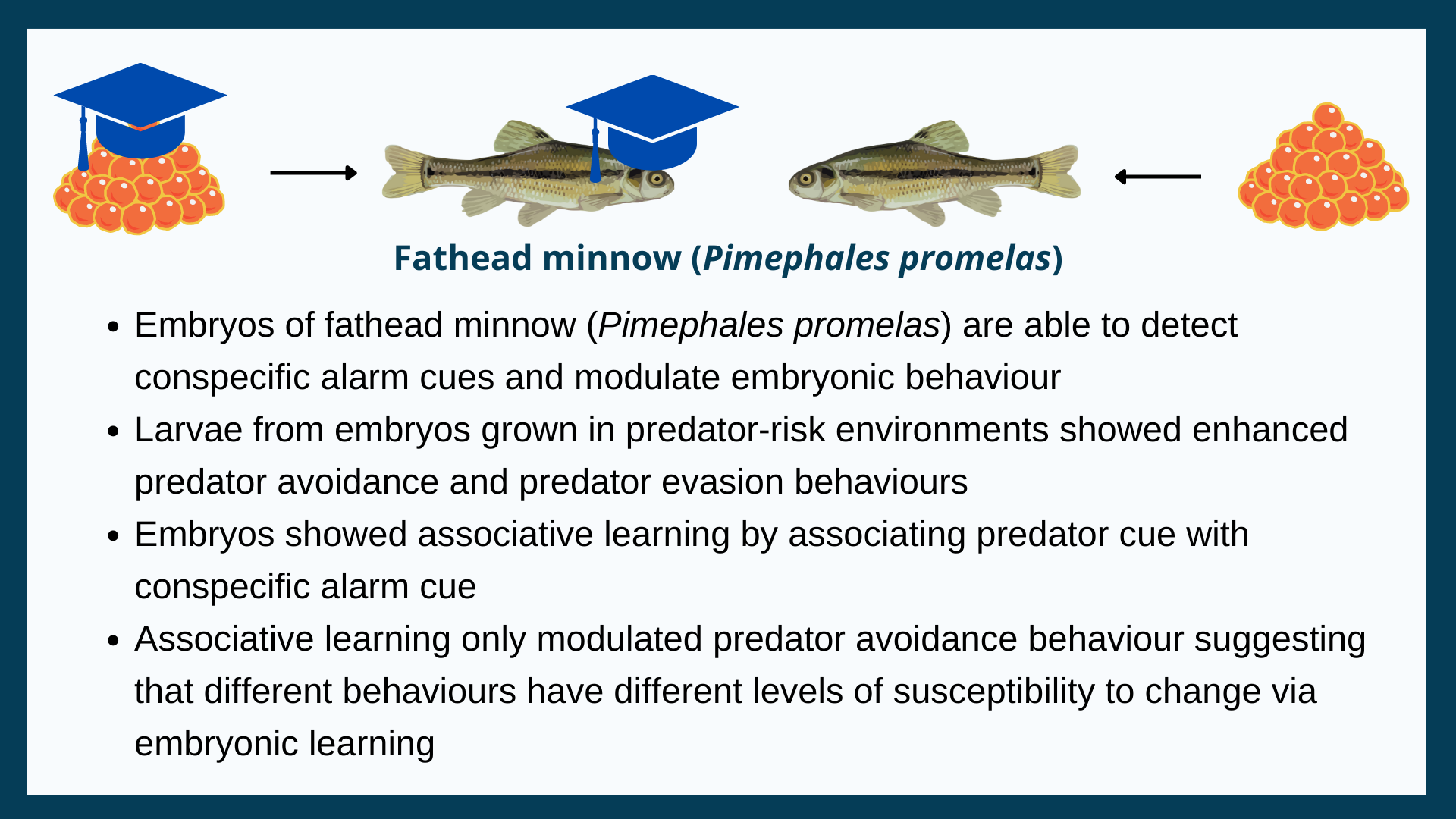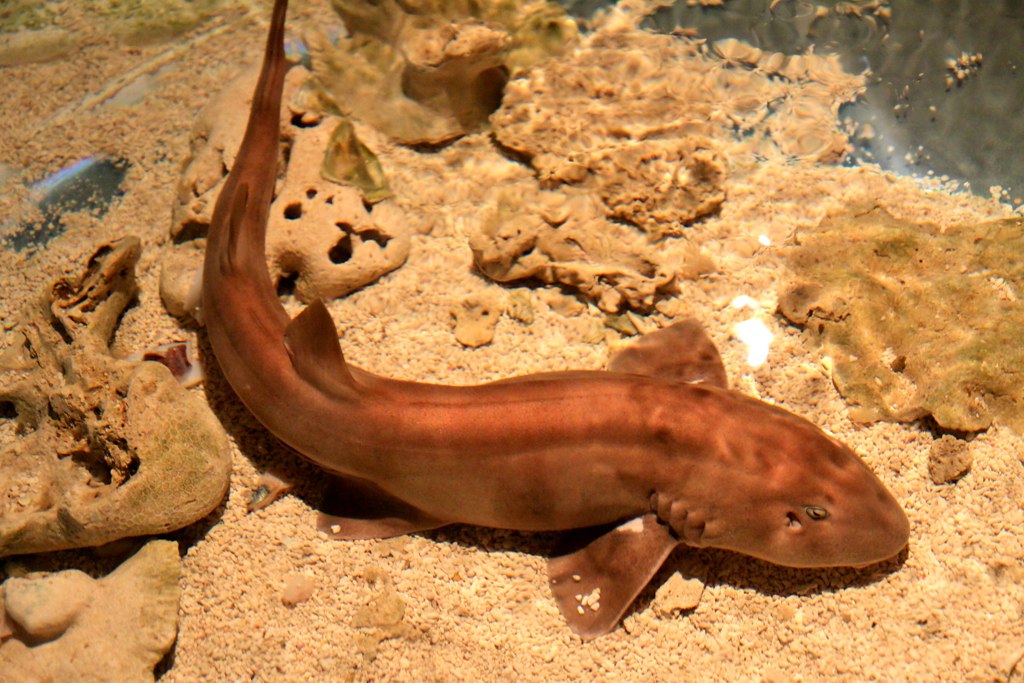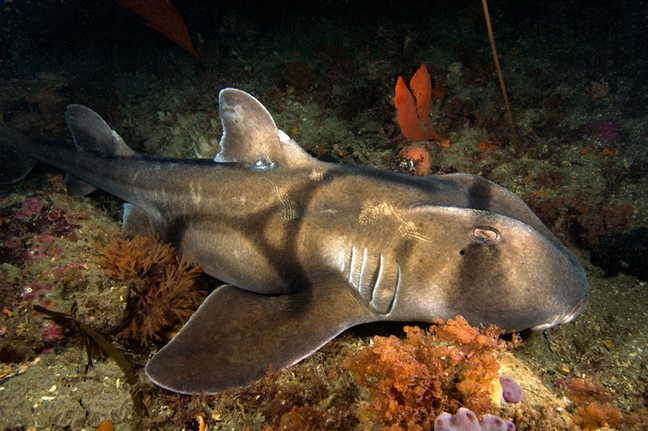1 TL;DR

Research article that is summarised in this post: Crowder, C., & Ward, J. (2022). Embryonic antipredator defenses and behavioral carryover effects in the fathead minnow (Pimephales promelas). Behavioral Ecology and Sociobiology, 76(2), 27. https://doi.org/10.1007/s00265-022-03136-2
2 Introduction
Learning is the process of acquiring information through experience. In nature, learning is ubiquitous in many different organisms and offers fitness advantages. Honeybees are known to learn floral features and utilize them during foraging (Review: 2), Wolf spiders (family Lycosidae) learn to avoid lesser quality prey when higher quality alternative prey is presented along with it (3), ants are known to learn and associate visual landmarks to their nest location (4). Learning is also particularly effective during different life stages. The experience acquired during the juvenile phase of an animal is known to affect their behaviour in adulthood. Baby Zebra finches (Taeniopygia guttata) are known to innately possess a ‘template song’ which is used as a base to learn and mimic songs sung by adult conspecifics. If baby zebra finches are isolated and not allowed to mimic the song, then when they reach adulthood, they develop irregular and abnormally sound songs as compared to experienced adults (5). In the Tobacco hornworm moth, an aversive odour stimulus when learned during their larval stage persists when they metamorphose into a moth (6). In houseflies, adults develop a preference for olfactory cues that were exposed to them during their larval stage (7).
3 Embryo is sensitive to external cues
Most studies in the context of learning focused on fitness advantages to adults when learning was manifested during the juvenile phase. But some organisms, especially oviparous organisms undergo their embryonic stage outside of their mother’s body where the embryos are in direct contact with the surrounding environmental cues. They are also found to be highly sensitive to these cues. Perhaps the most famous evidence for this would be gender determination in reptiles, where the eggs respond to their surrounding ambient temperature. Here, gender is determined by temperature values after fertilization (Review: 8). In addition to sensing environmental cues, many studies have also reported evidence of “embryonic learning”, where the embryos learn and form memories of surrounding environmental cues and utilize these memories in both the pre and post-embryonic period to modulate their behaviour. Some of the cases where the embryo is found to respond and/or learn external cues are given below;
- Eggs of ringed salamanders (Ambystoma annulatum, Figure 1) when exposed to chemical cues from predators resulted in reduced activity and greater shelter-seeking behaviour in larvae (9).
- Wood frog (Rana sylvatica, Figure 2) tadpoles learned to respond to chemical cues from unfamiliar predators when associated with conspecific alarm cues during the embryo stage (9).
- Naive cuttlefish (Sepia officinalis, Figure 3) prefer shrimps over crabs, but cuttlefish embryos which are visually conditioned with crabs preferred crabs over shrimps during the larval stage (10). Also, cuttlefish embryos that had experience with white crabs1 developed a preference for white crabs over black crabs2 during the larval stage (10). Moreover, cuttlefish larvae that received embryonic experience with white crabs exhibited prey generalisation where they prefer black crabs over shrimp (10).
- Cuttlefish embryos (Sepia officinalis, Figure 3) are also seen to reduce their ventilation rate in the presence of predator indicative cues, possibly to remain cryptic. Furthermore, cuttlefish embryos are also found to associate non-predator cues with predator cues to invoke reduced ventilation behaviour which showcases evidence for associative learning in these embryos (11).
- Rainbow trout embryos (Oncorhynchus mykiss, Figure 4) can learn both conspecific and heterospecific alarm cues and, rainbow trout fish with embryonic learning experiences had longer memory retention compared to the ones with no embryonic learning experience (12).
- Bamboo sharks (Chiloscyllium punctatum, Figure 5), like all sharks, have electroreception which is normally used to locate prey. But unlike most other sharks where the embryo is developed within the mother’s body, in bamboo sharks egg sacks containing the embryo are oviposited on substrates which makes them vulnerable to predation (13). It is known that bamboo shark embryos can use their electrosensory system to innately detect electric fields indicative of predators and thereby cease their respiratory gill movements to become cryptic (14).
- Port Jackson shark (Heterodontus portusjacksoni, Figure 6) embryos are found to modulate their oxygen uptake rates against predator (Crested horn sharks; Heterodontus galeatus) and non-predator (Sand whiting; Sillago ciliata) olfactory cues with respect to their developmental stages. In earlier developmental stages, the embryos reduced oxygen uptake against non-predator odour cues but not against predator cues, indicating a cryptic response, possibly because of neophobia. At later developmental stages, the embryos increased oxygen uptake against predator cues and but not against non-predatory cues. This possibly indicates a fight-or-flight response where increased oxygen levels can contribute to enhanced capacity for aerobic or anaerobic activities that can aid in successful evasion by fleeing (15).
- Cinnamon clownfish embryos (Amphiprion melanopus, Figure 7) are found to detect conspecific alarm cues and associate them with predator cues which resulted in increased heart rates (16). Increased heart rate is found to be positively correlated with anti-predator behaviours in fish.
These studies show that embryos can sense surrounding cues. The nature of surrounding cues also matters as some elicit innate behaviours and some don’t elicit any behaviour at all. For cues eliciting innate behaviours, some of the above-mentioned studies have shown that embryos can associate novel cues to these innately known cues and thereby change behaviour during the pre and/or post-embryonic stage.





4 Embryonic response to predatory cues
As seen earlier, embryonic response to predators is evident and this might be because of strong predation pressures as most aquatic oviparous organisms are highly vulnerable to egg predators. While most studies have looked at the effect of embryonic response in juvenile and adult life stages, it might also have an immediate effect on the embryo itself [as seen in the Cuttlefish (11), in Bamboo shark (14), in Port Jackson shark (15) and Cinnamon clownfish (16)].
So meet fathead minnow fish (Pimephales promelas), who share the same fate of being embryonic prey as the above-mentioned ones. The Fathead minnow is a freshwater fish species native to North America. They live in a school of up to a hundred individuals (17) but during the onset of the breeding season. males depart from school and adopt a solitary lifestyle (18). Females of this species lay their eggs in sites guarded by a single male (19), which hatch into larvae after 5 days of post-fertilization. They are some of the well-studied model organisms which display prominent anti-predatory behaviours. They are perhaps best known for “Schreckstoff” (Paper is in German: 20), a chemical alarm signal, which is only produced when they suffer tissue damage, which occurs most often from predator attacks. Fathead minnow innately responds to these alarm cues and associates them with predator cues (21). With varying levels of these alarm cues, solitary individuals show a combination of anti-predatory behaviours that include, dashing, freezing, slowing and exploring (22). If chased by predators, they show an increased rate of shoaling3 and shooling4 and, also show increased shelter-seeking behaviour (23). Field studies have shown that they actively avoid areas containing heterospecific alarm cues (21). However, they are not reported to innately identify any predators (24).
This complex behaviour repertoire is only reported to be present in juveniles and adults (well no surprises there!). But fathead minnow starts their life cycle as eggs and faces high rates of predation (25). The embryonic stage is by far the worst period to get predated on as the embryos are heavily handicapped due to their immobility. Nevertheless, they are known to alter hatching times in response to predator cues (26). Moreover, when predator cues in combination with cues indicating embryo damage were introduced to embryos, the developed larvae from these embryos were small in size, indicating loss of developmental maturity (26). But in the presence of conspecific alarm cues, hatching times remain unchanged (27). Therefore these results suggest that fathead minnow embryos can sense environmental cues but clear-cut evidence was lacking. This is exactly what was explored by graduate student Christopher Crowder and Dr. Jessica Ward at Ball State University, Indiana, USA. in their recent paper (1). The researchers asked whether fathead embryos can innately detect alarm cues just like their adult counterparts and if they do, then does that embryonic experience affect pre and/or post-embryonic behaviours?
5 Methods and results
To initiate embryonic experience, researchers grew the embryos in four different environments imparting “predator-risk” and “non-predator-risk” experiences.
| Environment | Condition |
|---|---|
| Environment 1 | Embryos reared in a control condition (just water with no other cues) |
| Environment 2 | Embryos reared with predator cues |
| Environment 3 | Embryos reared with conspecific alarm cues |
| Environment 4 | Embryos reared with predator + conspecific alarm cues |
Except for environments 1 and 2, all other environments indicated predator risk. Since the fatheaded minnow shows no innate behaviour against any predators, environment 2 (predator cue) should be similar to environment 1 (control). If associative learning occurs in fathead minnow embryos then the larvae which came from environment 4 should be able to associate the predator cue to the alarm cue, which can later be tested through behavioural assays. As adult fathead minnows are known to innately respond to conspecific alarm cues, environments 3 and 4 can be indicative of predation pressure and embryos should be able to detect them.
As fathead minnows show embryonic locomotor activity, it might make them conspicuous to egg predators. Interestingly, when locomotor activity was checked 5 days post fertilization, embryos from predator-risk environments (env. 3 and 4) showed lower motor activity, possibly indicating a cryptic response. This suggests that embryos can detect alarm cues like their adult counterparts.
After testing for locomotor activity, the embryos were then grouped according to the environments they were raised in and were placed in separate control tanks devoid of alarm or predator cues. The embryos were allowed to hatch, and at 22 days post fertilization, the larvae were tested for predator avoidance behaviour and predator evasion behaviour. The idea was that larvae from predator-risk environments should show enhanced predator avoidance and evasion behaviours.
Therefore, researchers tested the larvae individually on a test arena where swimming activity was checked before and after applying a stimulus. Four different stimuli were used which were synonymous with the environments. Here swimming activity was measured, which acted as a proxy to the ‘freezing’ behaviour fathead minnow showed, which is a predator avoidance behaviour. Lower swimming activity corresponds to enhanced predator avoidance behaviour, as lower activity might make them more cryptic to predators.
The four stimuli that were used are;
| Stimulus | Condition |
|---|---|
| Stimulus 1 | Control (absence of predator or alarm cues) |
| Stimulus 2 | Predator cue |
| Stimulus 3 | Conspecific alarm cue |
| Stimulus 4 | Predator + conspecific alarm cues |
Larvae from the predator risk environments (env. 3 and 4) should show enhanced freezing behaviour when predator risk stimuli (stimuli 3 and 4) are presented, compared to the control stimulus. Stimulus 2 should also elicit enhanced freezing behaviour if the embryo was able to associate the predator cue with the alarm cue (i.e. associative learning occurred in embryos indicating evidence for embryonic learning)
Researchers found that before stimulus use, larvae from predator-risk environments (env. 3 and 4) had decreased swimming activity. This is in conjunction with earlier mentioned studies, where it was shown that embryos which experience predator indicative cues showed an overall decrease in activity in post-embryonic stages. Upon stimulus usage, the same trend followed, larvae from predator-risk environments had an overall decreased swimming activity for all stimuli administration instances. Both these results indicate that the larvae from predator risk environments (env. 3 and 4) showed enhanced predator avoidance behaviour compared to larvae from non-predator risk environments (env. 1 and 2). In the case of larvae from environment 4 (predator + alarm cues), when the predator cue was administered, it showed reduced swimming activity compared to the control. But the difference was not statistically significant. The level of significance for this study was chosen to be and the p-value for the difference between swimming activity when predator cue stimulus was used compared to control stimulus usage was 0.05 (same as the value), as reported in the paper. But that does not rule out its biological significance and the researchers assert that associative learning has occurred. For larvae from environment 1 (control), except for the control stimulus, all other stimuli administration resulted in reduced swimming activity. This was a strange finding and the researchers suggested that it might be because of neophobia.
The next anti-predatory behaviour researchers looked at was predator evasion behaviour. As mentioned before, researchers hypothesized that larvae from predator-risk environments (env. 3 and 4) should show enhanced evasion behaviours. To quantify evasion behaviour, two parameters were measured; maximal body curvature and latency to respond to simulated predator attack. When a fish tries to escape from a predator, it bends its body into a “C” shape to generate momentum drag. The maximal body curvature is the angle formed when the “C” shape is formed in a fish. A shorter angle means that the body bend is greater indicating an enhanced escape behaviour. Overall, it was found that predator risk environments (env. 3 and 4) have resulted in reduced body curvature angle, indicating enhanced evasion behaviour in the larvae. But the evidence for associative learning was not present in this case, as for larvae from environment 4 (predator + alarm cues), upon predator cue administration, the maximal body curvature angle was not significantly different from the control. Latency to respond was found to be independent of embryonic environment and stimulus administration, as no change was observed between the groups. This indicates that post-embryonic behaviour can have varying levels of susceptibility to modification via embryonic learning.
6 Conclusion
The researchers showed, for the first time in fathead minnow embryos (Pimephales promelas), that they can detect conspecific alarm cues, moreover, they also showed that;
- In addition to detecting conspecific alarm cues, the embryos, in response to its detection also modulated their embryonic locomotor activity to become cryptic, indicating an immediate adaptive response within the embryos
- Embryonic experience overall enhanced predator avoidance and evasion behaviours
- Embryonic associative learning only modulated predator avoidance and not evasion behaviour in the larvae, indicating a varying level of susceptibility to modification via embryonic learning
The evidence for associative learning in this study did not achieve statistical significance and was in a borderline area (p = 0.05, same as ) but that does not mean there is no biological significance. As sample sizes were adequate, we can explore some possible future directions.
- The predator cue used in this study came from a known egg predator of fathead minnow, the blue gill sunfish (Lepomis macrochirus). Using another predator cue in association with the conspecific alarm cue can mitigate any possible intrinsic effect the previous predator cue had in learning.
- As fathead minnows were trained to associate predator cues to conspecific alarm cues throughout 5 days post fertilization as embryos and were only tested 22 days post fertilization as larvae. There was a significant time gap between training and testing which might have corroded its memory. But fathead minnows are known to form long-lasting associations between odour cues and other cues. In an earlier study (28), fathead minnow was shown to distinguish between familiar shoal mates and unfamiliar conspecifics, and they were able to maintain this discriminability even after 2 months of separation suggesting evidence for a long-lasting memory. I did not find any other studies which have exclusively looked at learning and memory in fathead minnow. An interesting experiment to follow up would be, training fathead minnow embryos to associate a predator cue to the conspecific alarm and testing this association at different ages after hatching. This can again check if embryonic associative learning occurred? if it occurred then how does the memory fare with increasing time interval between last association and larval age.
In conclusion, this study (1) showcased a whole new aspect of learning in fathead minnow (Pimephales promelas) which opens up new avenues of research questions given their peculiar behaviour and life history.
References
Footnotes
Reuse
Citation
@online{johnson2022,
author = {Johnson, Jewel},
title = {Learning Starts in the Embryo for Fathead Minnow Fish},
date = {2022-07-22},
url = {https://sciquest.netlify.app//posts/research_article_embryonic_learning/index_post.html},
langid = {en}
}
